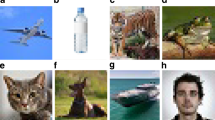Abstract
A novel neural network called Class Directed Unsupervised Learning (CDUL) is introduced. The architecture, based on a Kohonen self-organising network, uses additional input nodes to feed class knowledge to the network during training, in order to optimise the final positioning of Kohonen nodes in feature space. The structure and training of CDUL networks is detailed, showing that (a) networks cannot suffer from the problem of single Kohonen nodes being trained by vectors of more than one class, (b) the number of Kohonen nodes necessary to represent the classes is found during training, and (c) the number of training set passes CDUL requires is low in comparison to similar networks. CDUL is subsequently applied to the classification of chemical excipients from Near Infrared (NIR) reflectance spectra, and its performance compared with three other unsupervised paradigms. The results thereby obtained demonstrate a superior performance which remains relatively constant through a wide range of network parameters.
Similar content being viewed by others
References
Skapura DM. Neural Networks: Algorithms, Applications & Programming Techniques. Addison-Wesley, Reading, MA, 1991
Beal R, Jackson T. Neural Computing. Adam Hilger, 1990
Rumelhart DE, McClelland JL, editors. Parallel Distributed Processing: Explorations in the Microstructure of Cognition. Foundations, Vol. 1. MIT Press, 1986
Xu L. Least Mean Square Error Reconstruction Principle for Self-Organising Neural-Nets. Neural Networks 1993; 6: 627–648
Masuda T. Model of Competitive Learning Based Upon a Generalised Energy Function. Neural Networks, 1993; 6: 1095–1103
Becker S. Unsupervised Learning Procedures for Neural Networks. International Journal of Neural Systems, 1991; 1 (2): 17–33
Hertz J, Krogh A, Palmer RG. Introduction to the Theory of Neural Computation. Addison-Wesley, Reading, MA, 1991
Kohonen T. Self-organisation and Associative Memory. Springer-Verlag, 3rd Edition, 1989
Willshaw DJ, Von der Malsburg C. How Patterned Neural Connections Can Be Set Up by Self-organisation. Proc Roy Soc Lond B 1976; 194: 431–445
Kohonen T. Physiological Interpretation of the Self-Organising Map Algorithm. Neural Networks 1993; 6: 895–905
Hsieh KR, Chen WT. A Neural Network which Combines Unsupervised and Supervised Learning. IEEE Transactions on Neural Networks 1993; 4 (2): 357–360
Hecht-Nielsen, R. Counterpropagation Networks. Proc First IEEE Int Conf Neural Networks 1987; 2: 19–32
Hecht-Nielsen R. Neurocomputing. Addison-Wesley, Reading, MA, 1990.
Hecht-Nielsen R. Counterpropagation Networks. Applied Optics 1987; 26 (23): 4979–4984
Hecht-Nielsen R. Applications of Counterpropagation Networks. Neural Networks 1988; 1 (2): 131–139
Stork DG. Counterpropagation Networks: Adaptive Hierarchical Networks for Near-Optimal Mappings. Synapse Connection 1988; 1 (2): 9–11
Widrow B, Hoff M. Adaptive Switching Circuits. IRE WESCON Convention Record 1960; (4): 96–104
Mackenzie MD. Counterpropagation Networks Applied to the Classification of Alkanes Through Infrared Spectra. Neural Computing and Applications 1994; 2 (2): 111–116
NeuralWare. Neural Computing. NeuralWare Inc., 1991
Kohonen T. Statistical Pattern Recognition with Neural Networks: Benchmark Studies. Proc Second Ann IEEE Int Conf Neural Networks, Vol 1, 1988
Pal NR, Bezdek JC, Tsao ECK. Generalised Clustering Networks and Kohonen's Self-Organising Scheme. IEEE Trans Neural Networks 1993; 4 (4): 549–557
Stewart C, Lu YC, Larson V. A Neural Clustering Approach for High Resolution Radar Target Classification.Patt Recognition 1994; 27 (4): 503–513
Desieno D. Adding a Conscience to Competitive Learning. Proc Second IEEE Int Conf Neural Networks, Vol 1, 1988: 117–124
Huang SC, Huang YF. Bounds on the Number of Hidden Neurons in Multilayer Perceptrons. IEEE Trans Neural Networks 1991; 2 (1): 47–55
Kolmogorov AN. On the Representation of Continuous functions of Many Variables by Superposition of Continuous Functions of One Variable and Addition. Dokl Akad Nauk 1957; 14: 953–956
Ash T. Dynamic Node Creation in Backpropagation Networks. Connection Science, 1989; 1 (4): 365–375
Azimi-Sadjadi MR, Sheedvash S, Trujillo FO. Recursive Dynamic Node Creation in Multilayer Neural Networks. IEEE Trans Neural Networks 1993; 4 (2): 242–256
Fletcher P. A Self-Configuring Network. Connection Science 1991; 3 (1): 35–60
Fahlman SE. The Cascade Correlation Learning Architecture. School of Computer Science Report CMU-CS-90-100, 1990, Pittsburgh, PA Carnegie Mellon University
Fletcher P. Principles of Node Growth and Node Pruning. Connection Science 1992; 4 (2): 125–141
Mozer MC, Smolensky P. Using Relevance to Reduce Network Size Automatically. Connection Science 1989; 1 (1): 3–16
Bartlett EB. Dynamic Node Architecture Learning: An Information Theoretic Approach. Neural Networks 1994; 7 (1): 129–140
Goodhill GJ, Barrow HG. The Role of Weight Normalisation in Competitive Learning. Neural Computation 1993; 6: 255–260
Carrara E, Pagliari F, Nicolini C. Neural Networks for the Peak-Picking of Nuclear Magnetic Resonance Spectra. Neural Networks 1993; 6: 1023–1032
Curry B, Rumelhart D. A Neural Network which Classifies Mass Spectra. Tetrahedron Computer Methodology 1990; 3: 213–237
Munk ME, Madison MS, Robb EW. Neural Network Models for Infrared Spectrum Interpretation. Mikrochimica Acta 1991; 2 (1–6): 505–514
Robb EW, Munk ME. A Neural Network Approach to Infrared Spectrum Recognition. Mikrochimica Acta 1990; 1 (3–4): 131–155
Weigel UM, Herges R. Automatic Interpretation of Infrared Spectra: Recognition of Aromatic Substitution Patterns Using Neural Networks. J Chem Inf Sci 1992; 32: 723–731
Novic M, Zupan J. 2-D Mapping of Infrared Spectra using Kohonen Neural Network. Vestnik Slou Kem Drus 1992; 39: 195–212
Author information
Authors and Affiliations
Rights and permissions
About this article
Cite this article
Mackenzie, M.D. CDUL: Class directed unsupervised learning. Neural Comput & Applic 3, 2–16 (1995). https://doi.org/10.1007/BF01414172
Received:
Issue Date:
DOI: https://doi.org/10.1007/BF01414172




